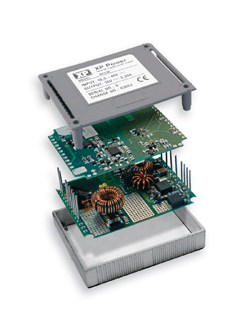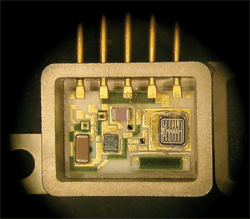Can a COTS dc/dc converter match up to a hybrid solution for demanding military and aerospace applications?
BY MARTIN BRABHAM
XP Power
Littleton, MA
http://www.xppower.com
It’s difficult to overstate how significant the shift in attitudes has been toward using commercial components for defense and aerospace applications. Many years since its inception, the concept of COTS has repeatedly come up against resistance and, equally, has ably defeated arguments against its adoption.

This COTS converter stacks PCBs to make use of 3-D space.
It would be naive to suggest the use of commercial components is applicable in all scenarios and not even the most ardent supporter of COTS could realistically make a sound case against the use of specialist devices where no suitable COTS alternative exists. But in the same spirit, condemning those alternatives without trial is equally extreme. And yet some engineers seem to approach evaluating MIL SPEC devices, particularly where the devices in question are dc/dc converters, with some trepidation. The reason behind this could reside more in their construction than their functionality.
The fundamentals of dc/dc conversion are well understood and widely deployed, in all sectors and vertical markets. Applying those principles, therefore, represents minimal challenge to specialist suppliers in terms of delivering electrical performance.
Military specs
In order to be considered for military applications, converters need to meet electrical specifications such as MIL STD 461E for EMI, MIL STD 1275A-D AND 704A-F for input surges and transients, and environmental requirements covered under MIL STD 810 such as shock, vibration, altitude and salt atmosphere. Here, there is no difference between hybrid and commercial off-the-shelf (COTS) products.
The ability to meet customers’ end product specification without the need for additional components, whilst retaining all the benefits of COTS, is typically where doubt creeps into the minds of engineers. But by considering the key requirements and evaluating the supplier against them, that doubt can be removed.
COTS vs. hybrids
The primary benefits of COTS are use of latest technology, simplified manufacturing, shorter leadtimes, and lower unit cost. By manufacturing devices in production volumes, and utilizing commercially available components and processes, economies of scale come in to play and unit pricing is driven down.
For hybrid converters, these economies simply aren’t present. But the issues go deeper. Physical attributes such as size and weight play an important role in selection.
Hybrid converters make good use of bare die, which offers smaller packaging and improved heat dissipation. This, in turn, can lead to what appears as a small overall size.
However, it isn’t uncommon for manufacturers’ datasheets to omit details of the necessary external components when quoting converter dimensions; components that are much more easily incorporated into the construction of COTS converters, thanks to the use of multiple PCBs and 3-D design.
For example, inductor and capacitor networks, which aren’t normally attached to the substrate, require secure bonding inside the hybrid enclosures, where space is already limited, so often need to be added externally.
COTS designs on the other hand will often use new technologies such as planar magnetics and miniature SMD components to achieve smaller sizes than traditional hybrids.
Anyone familiar with military manufacturing practices may expect conformal coating to be standard practice for hybrid converters. However, this is not the case, nor does the design lend itself to encapsulation.

Picture of hybrid before sealing showing wires and conductors that need securing.
Instead, environmental protection is often provided through hermetic sealing, via a glass or ceramic seal. This can become prone to damage during manufacturing, test or preparation, and once a hermetic seal is broken, the bare dies and other exposed surfaces in a hybrid device are particularly vulnerable to corrosion.
This glass or ceramic seal approach is also used to insulate pins from the metal case, incurring intricate manufacturing processes.
COTS designs that target high-reliability applications are almost always fully potted, a process that coupled with good design helps pass the tough MIL STD 810 salt/fog test and provide long-term integrity.
As well as providing excellent protection against shock, vibration and salt/fog exposure, the potting compound also provides good thermal conductivity to the case.
Hybrid converters are generally specified to operate at the higher temperature of 125C, while COTS converters are normally limited to a maximum baseplate temperature of 100C. If the application calls for full power at 125C, the construction style of short thermal paths typified by hybrid converters can offer an advantage over COTS devices.
Performance
The application of commercial components in MIL SPEC systems is mimicked, to an extent, by the transference of technology originally developed for high-reliability environments to mass-market applications.
At the same time, there is little doubt that a gap in the market exists for dc/dc converters that fall between full MIL SPEC parts and traditional commercial components.
These significant savings can give rise to concerns over quality, reliability, and applicability. However, as shown here, through good design, an understanding of the key requirements, and a heritage in leading-edge manufacturing practices, it is possible to bridge that gap with a range of products that meet these overriding requirements, all the while retaining the essence of COTS. ■
Get more information on dc/dc converters at http://electronicproducts-com-develop.go-vip.net/power.asp.
Advertisement
Learn more about XP Power





